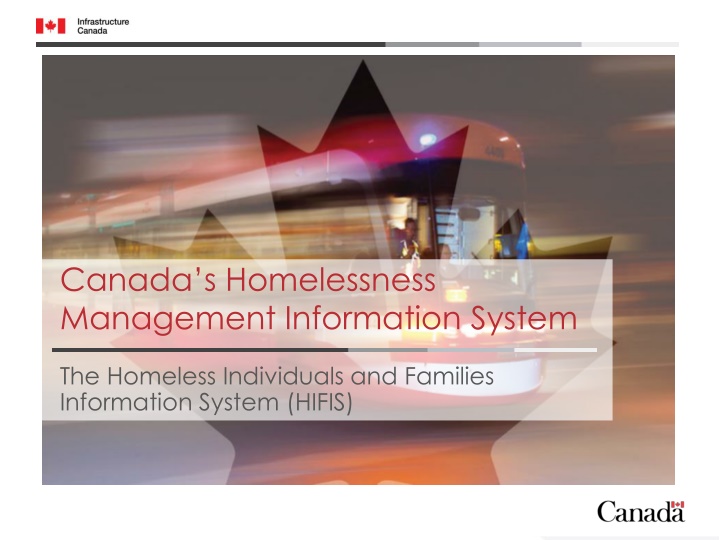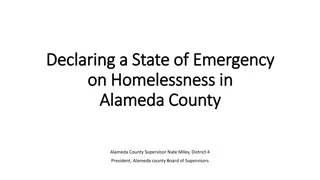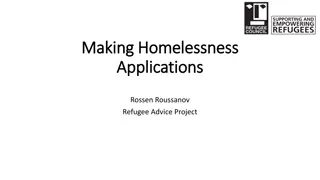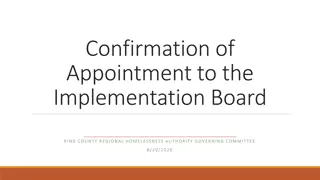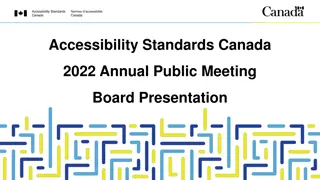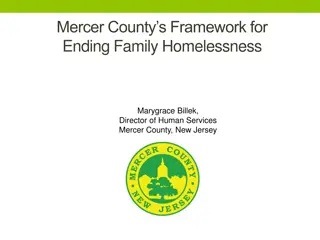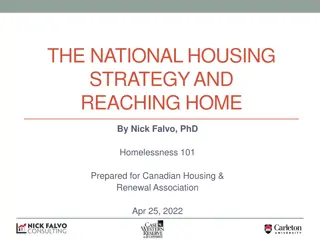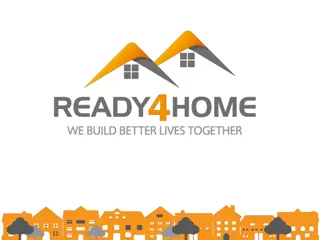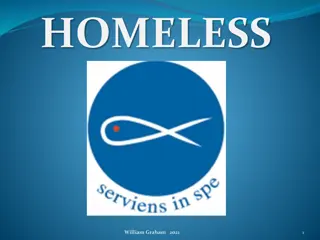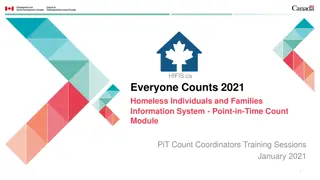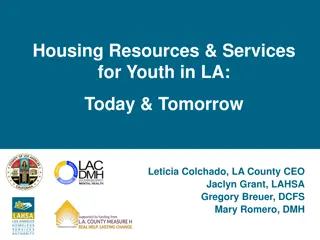Canada's Homelessness Management Information System (HIFIS) Overview
Canada's Homelessness Management Information System (HIFIS) is a comprehensive web-based data collection and case management system designed to support service providers in managing real-time client data, promoting community collaboration, and enhancing the understanding of local homelessness and housing resources. HIFIS plays a crucial role in Coordinated Access by facilitating the collection of reliable data, reducing administrative burdens, and providing a unified service experience for individuals and families experiencing homelessness. The system has evolved over the years to incorporate enhancements and improvements, making it an essential tool in addressing homelessness in Canada.
Download Presentation

Please find below an Image/Link to download the presentation.
The content on the website is provided AS IS for your information and personal use only. It may not be sold, licensed, or shared on other websites without obtaining consent from the author.If you encounter any issues during the download, it is possible that the publisher has removed the file from their server.
You are allowed to download the files provided on this website for personal or commercial use, subject to the condition that they are used lawfully. All files are the property of their respective owners.
The content on the website is provided AS IS for your information and personal use only. It may not be sold, licensed, or shared on other websites without obtaining consent from the author.
E N D
Presentation Transcript
Canadas Homelessness Management Information System The Homeless Individuals and Families Information System (HIFIS)
Canadas Homelessness Management Information System Overview HIFIS and Coordinated Access The Evolution of HIFIS The Benefits of HIFIS Some Key Features of HIFIS Data Collection Data Sharing and Data Use Data Protection and Data Security 2
Canadas Homelessness Management Information System HIFIS and Coordinated Access What is HIFIS? HIFIS is a comprehensive web-based, data collection and case management system designed to support the day-to-day operational activities of service providers and Coordinated Access HIFIS empowers service providers from the same community to collect, manage, and share real-time data on their clients. Why is HIFIS essential to Coordinated Access? Supports the collection of reliable, real-time homelessness data that can be shared through a centralized database ensuring clients can be triaged appropriately and, when vacancies become available, prioritized for resources. Reduces administrative burden. Service providers can start, update and share service plans when working with common clients. Reports can be customized to meet various needs. This helps creates a unified service experience. Can generate data for core outcomes of Reaching Home: homelessness/eviction prevention, Indigenous homelessness, chronic homelessness, and measures of client inflow and outflow. 3
Canadas Homelessness Management Information System The Evolution of HIFIS HIFIS 1 HIFIS 2 HIFIS 3 HIFIS 4 Enhancements Enhancements 1999 2002 2006 2015 2020 2022 An internal desktop application to collect data for the Government of Canada with expanded functionalities. A web- based application that is user- friendly and highly configurable to support the shift towards Coordinated Access. A desktop application driven by the community. Inclusion of the Coordinated Access module; addition of a Unique Identifier List. Improvements to the Coordinated Access module. An internal desktop application to collect data for the Government of Canada. 4
Canadas Homelessness Management Information System HIFIS Benefits Clients A client management system that eliminatesthe clients need to repeat their personal history during their intake/assessment. A client management system that assists with referring clients to the right services at the right time. Service Providers and Communities A data collection and sharing system that encourages community collaboration to support service planning. A data collection and sharing system that enables the development of reports that improve the understanding of local homelessness and housing resources A client management system that provides access to various assessment tools that streamlines intake and prioritization process of clients. Homeless-serving Sector A data collection and sharing system that contributes to the national understanding of homelessness. A data collection and sharing system that informs and advances research and policy development including identifies gaps in the sector. 5
Canadas Homelessness Management Information System Key Features of HIFIS Key Features Web Environment Highly Configurable HIFIS Support and Services Custom Reports Client Assessments Point-in-Time (PiT) Counts Unique Identifier List (By- Name List) Integrated consent Communication Tools (broadcasts and bulletins) HIFIS allows for seamless service delivery. Service providers can build on each other s service planning when working with common clients, creating a unified service experience. 6
Canadas Homelessness Management Information System Data Collection What types data does HIFIS collect? Communities can collect over 1000 various data points. Communities decide what data they wish to collect (excluding the mandatory export fields). INFC collects 38 non-directly identifiable exportfields. What are the 38 non-directly identifiable export fields, and how are they collected? The 38 non-directly identifiable export fields are mandatory data fields collected through HIFIS and automatically anonymized and encrypted, and exported to INFC each quarter. These fields include: Service Provider Information (e.g., service provider ID), Client Information (e.g., country of origin), Shelter Stay Information (e.g., reason for service), and Turn-away Information (e.g., reason for turn-away). The HIFIS Data Provision Agreement is an agreement between the HIFIS Lead organization and INFC. It details roles and responsibilities, and authorizes INFC s collection of the non-directly identifiable export fields. 7
Canadas Homelessness Management Information System Data Sharing and Data Use How is HIFIS data shared? Community B Community A Each Community has a HIFIS lead organization that is responsible for the installation, configuration, and maintenance of HIFIS for their local community service providers. Local Service Provider Local Service Provider Local Service Provider Local Service Provider HIFIS Lead Org. HIFIS Lead Org. How is HIFIS data used by INFC? INFC INFC uses the 38 non-directly identifiable export fields to support research and analysis on homelessness in Canada and the homeless- serving sector, which contributes to evidenced-based policy and decision-making and publications (e.g., the National Shelter Study and the Shelter Capacity Report). Under Reaching Home: Canada s Homelessness Strategy, the Designated Communities stream and the Territorial Homelessness streamare required to adopt HIFIS if the community does already have an equivalent HMIS in place. 8
Canadas Homelessness Management Information System Data Sharing and Data Use Different Levels of data sharing in HIFIS: Layer Area in HIFIS 4 Examples of Fields / Modules Name/Alias Date of Birth/Age Gender Privacy Details Layer 1 Shared Client List Shared. Most HIFIS Users can view this information. Layer 2 Client Information Indigenous Status Veteran Status Financial Profile Family Status Education History Housing History Shareable. Most HIFIS Users can view this information if their organization has attested that they are serving the client. Layer 3 Client Management Admissions Service Restrictions Turnaways Goods and Services Assessments Case Management Incidents Limited sharing. As a default in HIFIS, some details from these modules are shared between Service Providers, but full details can only be seen by Users at the Service Provider that entered the information. Locally, some of these modules may become visible across Service Providers to allow for shared service planning for mutual clients. 9
Canadas Homelessness Management Information System Data Protection and Data Security A Shared Responsibility NEEDED PROVIDED IT GOVERNANCE HIFIS Configurable access and viewing rights Activity and audit logs Integrated help centre Encrypted data exports Granular configurations at the source-code level User-rights flexibility The ability to be clustered Define roles & responsibilities Define user access rights Develop and standardize policies and procedures Develop applicable agreements (e.g., client consent form) Secure server Local encryption Firewall Establish user- rights Back-ups and safeguards On-site technical expertise ACTIVITY Collected data are secured from accidental data loss and/or external threats Integrated and customizable privacy functions enables data to be collected, shared, and exported securely and privately OUTCOME Community roles, priorities, and data needs are clearly defined 10
Canadas Homelessness Management Information System HIFIS Implementation How is HIFIS implemented in the community? INFC develops HIFIS internally and provides a license to our Community Entities to host, install, and implement HIFIS locally in their community (or in the case of some jurisdictions provincially). INFC continues to maintain and update the system through a series of releases to address bug fixes, and increase functionalities on key priorities both with the community and for INFC, such as Coordinated Access functionalities. The community is responsible for implementing and configuring HIFIS based on the needs of their community and through community consultation what service providers need access, what roles and responsibilities service providers have. This includes: Planning, a Needs Assessment, Designing how that will work within the confines of how HIFIS operates, and providing training and maintaining the system. 11
How HIFIS Development gets Prioritized? Lots of requests for enhancements Three main groups: 1. Data Collection (Data In) 2. Data Reporting (Data Out) 3. Application (HIFIS Software)
THANK YOU Additional Resources Coordinated Access Guide For more information on Coordinated Access https://www.homelessnesslearninghub.ca/library/resources/reaching-home-coordinated-access- guide HIFIS Website For more information on HIFIS http://www.hifis.ca/ HIFIS Demo Site For a hands-on experience with HIFIS https://demo.hifis.ca/ Reaching Home Newsletter For the latest news and updates on the Reaching Home program, please sign up to the email distribution list. info@hifis.ca HIFIS Newsletter For the latest news and updates on HIFIS, please sign up to the email distribution list. support@hifis.ca Homelessness Learning Hub (HIFIS Toolkit) For access to a wide range of free supporting documents on Coordinated Access, HIFIS, and Reaching Home. https://www.homelessnesslearninghub.ca/library/resources/hifis-implementation-guide HIFIS Client Support Center For all inquires regarding HIFIS. support@hifis.ca and 1-866-324-2375 13
ANNEX A The 38 Non-directly Identifiable Export Fields Collected by INFC Shelter Information Shelter provider ID* Shelter provider name* Service provider type* Bed counts* Bed types* Community* Client Information (continued) Country of origin Education Sources of income Income start date Income end date Health conditions Housing types Housing start date Housing end date Client Information Unique client identifier* Gender* Year and month of birth* Family role* Family head ID* Citizenship/immigration status* Indigenous indicator* Veteran status* Life events Contributing factors Contributing factor start date Contributing factor end date Employment status Client Shelter Information Reason for service* Reason for discharge* Book-in date* Book-out date* Turnaway Informaiton Reason for turnaway* Date of turnaway* Anonymous gender* Anonymous age category* Anonymous Indigenous indicator (assumed) Anonymous disability indicator (observed) 14
